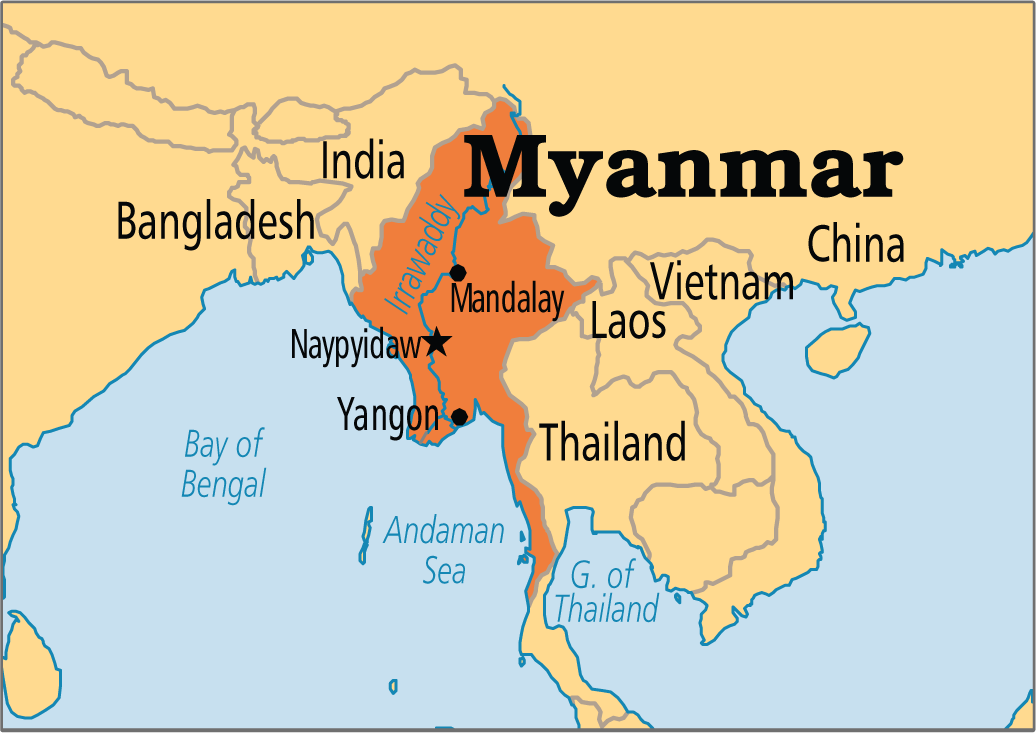International Relations
India-Myanmar
- 24 Dec 2021
- 8 min read
For Prelims: India- Myanmar Cooperation, Kaladan Multimodal Transit Transport Project, Rakhine State Development Programme, Border Area Development Programme.
For Mains: Significance of Myanmar for India, Coup in Myanmar and its implications for India, Act East policy, India’s “Neighborhood First” policy.
Why in News
Recently, India has provided 10 lakh doses of ‘Made in India' coronavirus vaccines and a grant of 10,000 tonnes of rice and wheat to Myanmar as part of its continued humanitarian support for the neighbouring country.
- It was the first visit of an Indian Foreign Secretary to Myanmar since Myanmar's military deposed the democratically-elected government of Aung San Suu Kyi in a coup on 1st February 2021.
Key Points
- Called for “return of democracy” at the “earliest” in the country and “release” of political prisoners; resolution of issues through dialogue; and complete cessation of all violence.
- Reaffirmed India’s strong and consistent support to the ASEAN initiative and expressed hope that progress would be made in a pragmatic and constructive manner, based on the five point consensus.
- The ASEAN five-point consensus states that there shall be an immediate cessation of violence in Myanmar and all parties shall exercise utmost restraint; constructive dialogue among all parties concerned shall commence to seek a peaceful solution in the interests of the people.
- Expressed India's continued support for people-centric socio-economic developmental projects, including those along the India-Myanmar border areas, as well as India’s commitment for expeditious implementation of ongoing connectivity initiatives such as the Kaladan Multimodal Transit Transport Project and the Trilateral Highway.
- Reiterated India’s commitment to continue with the projects under Rakhine State Development Programme and Border Area Development Programme for the benefit of the people of Myanmar.
- Emphasized that peace and security in the North East states are affected if there is instability in Myanmar.
- In the recent past, it is not just the Rohingyas who tried to enter India from Myanmar. According to reports, police personnel and others serving in Myanmar forces fled the country and took shelter in the North East states like Mizoram, Manipur.
India-Myanmar Ties
- Background:
- India and Myanmar relationship officially got underway after the Treaty of Friendship was signed in 1951, after which the foundation for a more meaningful relationship was established during Prime Minister Rajiv Gandhi’s visit in 1987.
- Muti-faceted Relationship:
- India and Myanmar have traditionally had much in common, with cultural, historical, ethnic, and religious ties, in addition to sharing a long geographical land border and maritime boundary in the Bay of Bengal.
- Geo-Strategic Location of Myanmar:
- Myanmar is geopolitically significant to India as it stands at the center of the India-Southeast Asia geography.
- Myanmar is the only Southeast Asian country that shares a land border with northeastern India, stretching some 1,624 kilometers.
- The two countries also share a 725-km maritime boundary in the Bay of Bengal.
- Confluence of Two Foreign Policy Doctrines:
- Myanmar is the only country that sits at the intersection of India’s “Neighborhood First” policy and its “Act East” policy.
- Myanmar is an essential element in India’s practice of regional diplomacy in the Indo-Pacific and serves as a land bridge to connect South Asia and Southeast Asia.
- Competition with China:
- If India is to become an assertive regional player in Asia, it has to work toward developing policies that would improve and strengthen its relationship with neighboring countries.
- However, in pursuance of this, China is a big roadblock, as it aims to diminish India’s influence in its neighborhood. Therefore, both India and China are fighting for gaining influence in Myanmar.
- For example, as part of its policy for the Indian Ocean called Security and Growth for All in the Region (SAGAR), India developed the Sittwe port in Myanmar’s Rakhine state.
- The Sittwe port is meant to be India’s answer to the Chinese-fronted Kyaukpyu port, which is intended to cement China’s geostrategic footprint in Rakhine.
- Critical for India’s National Security Interests:
- North-eastern states in India are affected by left-wing extremism and narcotics trade routes (golden triangle).
- To counter these threats, the Indian and Myanmar armies have carried out many joint military operations like Operation Sunshine.
- Economic Cooperation:
- Many Indian companies made significant economic and trade agreements in infrastructure and other areas.
- Some other Indian companies such as Essar, GAIL, and ONGC Videsh Ltd. have invested in Myanmar’s energy sector.
- To elevate its “Made in India” arms industry, India has identified Myanmar as key to increasing its military exports.
Way Forward
- Even as India continues to call for a restoration of the democratic process, both bilaterally and at various multilateral fora, it has to engage with the army in Myanmar to address Indian concerns as well as to make it a stakeholder that can deliver on the democratic front, including the release of political prisoners.
- Marginalising the army will only push it into China’s arms. Ever since the coup, China’s economic grip over Myanmar has only become tighter with a special focus on projects critical for the China-Myanmar Economic Corridor.
- India’s “Buddhist Circuit” initiative, which seeks to double foreign tourist arrivals and revenue by connecting ancient Buddhist heritage sites across different states in India, should resonate with Buddhist-majority Myanmar.
- The quicker the Rohingya issue is resolved, the easier it will be for India to manage its relations with Myanmar and Bangladesh, focusing instead more on bilateral and subregional economic cooperation.
- Finally, cooperation in different multilateral forums such as ASEAN and BIMSTEC strengthens the relationship between the two countries.





